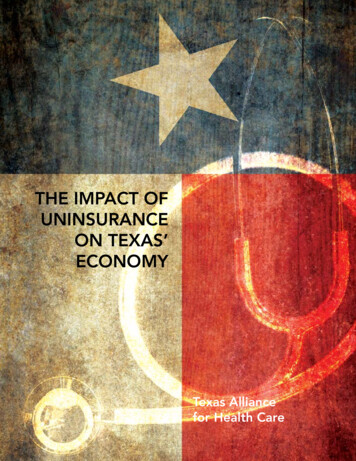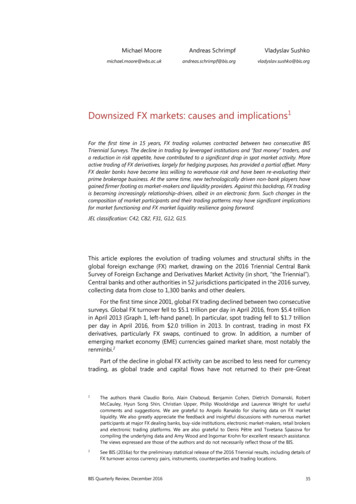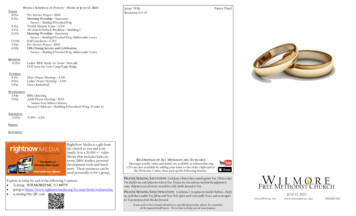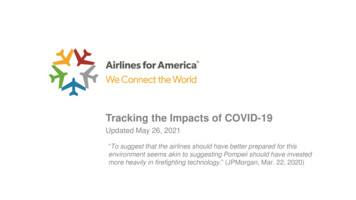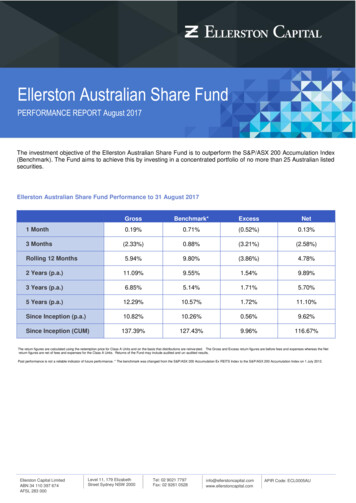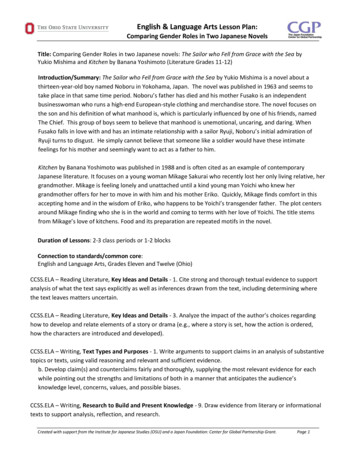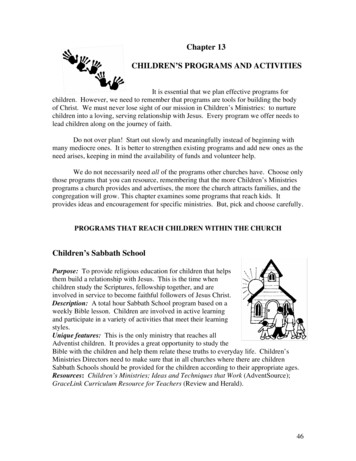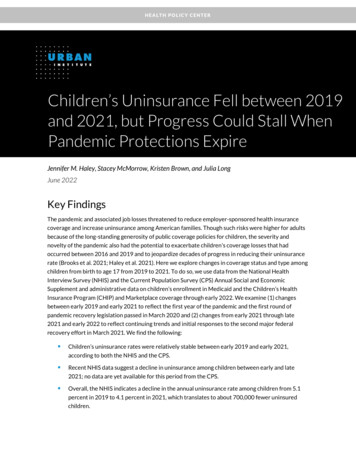
Transcription
HEALTH POLICY CENTERChildren’s Uninsurance Fell between 2019and 2021, but Progress Could Stall WhenPandemic Protections ExpireJennifer M. Haley, Stacey McMorrow, Kristen Brown, and Julia LongJune 2022Key FindingsThe pandemic and associated job losses threatened to reduce employer-sponsored health insurancecoverage and increase uninsurance among American families. Though such risks were higher for adultsbecause of the long-standing generosity of public coverage policies for children, the severity andnovelty of the pandemic also had the potential to exacerbate children's coverage losses that hadoccurred between 2016 and 2019 and to jeopardize decades of progress in reducing their uninsurancerate (Brooks et al. 2021; Haley et al. 2021). Here we explore changes in coverage status and type amongchildren from birth to age 17 from 2019 to 2021. To do so, we use data from the National HealthInterview Survey (NHIS) and the Current Population Survey (CPS) Annual Social and EconomicSupplement and administrative data on children’s enrollment in Medicaid and the Children’s HealthInsurance Program (CHIP) and Marketplace coverage through early 2022. We examine (1) changesbetween early 2019 and early 2021 to reflect the first year of the pandemic and the first round ofpandemic recovery legislation passed in March 2020 and (2) changes from early 2021 through late2021 and early 2022 to reflect continuing trends and initial responses to the second major federalrecovery effort in March 2021. We find the following: Children’s uninsurance rates were relatively stable between early 2019 and early 2021,according to both the NHIS and the CPS. Recent NHIS data suggest a decline in uninsurance among children between early and late2021; no data are yet available for this period from the CPS. Overall, the NHIS indicates a decline in the annual uninsurance rate among children from 5.1percent in 2019 to 4.1 percent in 2021, which translates to about 700,000 fewer uninsuredchildren.
Both survey and administrative data sources suggest public coverage increased among children between early 2019 and early 2021.»The NHIS indicates a significant 4.9 percentage-point increase in public coverage and aroughly corresponding decline in private coverage over the period.»Changes in coverage on the CPS are much smaller in magnitude and not statisticallysignificant but suggest offsetting public coverage gains and private coverage lossesbetween March 2019 and March 2021.»Administrative data show that approximately 4 million more children were enrolled inMedicaid/CHIP in March 2021 than in March 2019.Administrative data indicate further gains in Medicaid/CHIP and Marketplace enrollment among children between early 2021 and early 2022.Policies such as the continuous coverage provision in the Families First Coronavirus Response Act(FFCRA), which has prohibited states from disenrolling people from Medicaid during the COVID-19public health emergency since March 2020, appear to have limited the pandemic’s effects on children’scoverage rates. Enhanced Marketplace subsidies under the American Rescue Plan Act (ARPA), passed inMarch 2021, and other economic recovery efforts seem to have further protected children’s insurancecoverage. Together, these provisions may have even contributed to a decline in uninsurance by the endof 2021. The decline in children’s uninsurance observed on the NHIS is remarkable given the economicdownturn, and if it is confirmed by other federal surveys, policymakers will have a better understandingof which policies can successfully mitigate coverage losses during recessions. But without federal andstate actions to maintain the enhanced Marketplace subsidies and limit coverage losses when thecontinuous coverage requirement expires, children’s uninsurance could once again increase in 2022 andbeyond (Alker and Brooks 2022; Buettgens and Green 2022).BackgroundBuilding on decades of coverage gains, the uninsurance rate among children had reached a historic lowby 2016. This significant progress is partially attributable to the Affordable Care Act (ACA) Medicaidexpansion and federally subsidized Marketplaces (Haley, Kenney, Wang, Pan, et al. 2018; Karpman,Kenney, and Gonzalez 2018; Kenney et al. 2016a, 2016b, 2017; Lukanen, Schwehr, and Fried 2019;McMorrow and Kenney 2018). Starting in 2017, likely owing to federal and state policy changes, someof these gains were reversed, and hundreds of thousands more children had become uninsured by 2019.However, children still remained much more likely than parents and other adults to have coverage(Haley et al. 2021).In part, lower uninsurance among children owes to much more generous Medicaid/CHIP eligibilityrules than those for adults. In 2019, the median state extended Medicaid/CHIP eligibility to childrenwith family incomes up to 255 percent of the federal poverty level (FPL), and 19 states extendedeligibility to those with family incomes at or above 300 percent of FPL. That same year the medianeligibility threshold for adults was just 138 percent of FPL in states that had adopted the ACA Medicaid2CHILDREN’S UNINSURANCE FELL BETWEEN 2019 AND 2021
expansion, whereas eligibility was often below half the FPL for parents in the states that had notexpanded Medicaid.1 Further, nondisabled, nonpregnant adults without dependent children innonexpansion states had few pathways for eligibility at any income level. Immigration-related rules alsoremained less restrictive for children than for most adults (Brooks, Roygardner, and Artiga 2019). Inaddition, among those who qualify for Medicaid/CHIP, participation is much higher for children than forparents; an estimated 93.7 percent of children who were eligible for Medicaid/CHIP and had no othercoverage were enrolled in 2019 (Haley et al. 2021).When the pandemic began, many people worried that steep increases in unemployment wouldresult in losses of employer-sponsored insurance and therefore increase uninsurance rates amongworkers and their families, consistent with trends during prior recessions (Banthin and Holahan 2020;Banthin et al. 2020; Garrett and Gangopadhyaya 2020; Holahan and Chen 2011). However, Congressimplemented several policies intended to reduce coverage losses during the pandemic. In March 2020,the FFCRA implemented the continuous coverage requirement, which prohibited state Medicaidprograms from disenrolling people during the public health emergency (unless they move out of state orrequest to disenroll) in exchange for enhanced federal funding. This requirement applied to bothtraditional Medicaid and Medicaid-expansion CHIP programs but not separate CHIP programs.2 Bytemporarily eliminating regular reassessments of eligibility, this policy was expected to reduce “churn,”or transitions in and out of coverage, which can occur when family circumstances change or whenenrollees cannot complete reenrollment requirements despite still being eligible for coverage (Coralloet al. 2021; Osorio and Alker 2021). The ARPA, enacted in March 2021, included additional efforts toenhance the affordability of coverage, such as increases in the size of Marketplace premium subsidies.Data-collection difficulties related to the pandemic, such as disruptions in procedures for federalsurveys, have complicated efforts to measure changes in coverage since 2019 (Ruhter et al. 2021). Someevidence from the US Census Bureau’s Household Pulse Survey showed an increase in uninsuranceamong adults early in the pandemic (Bundorf, Gupta, and Kim 2021; Gangopadhyaya, Karpman, andAarons 2020). However, recent evidence from the NHIS, the CPS, and the Urban Institute’s HealthReform Monitoring Survey suggests the uninsurance rate among nonelderly adults remained relativelyflat between early 2019 and early 2021, with gains in public coverage offsetting losses of privatecoverage (McMorrow et al. 2022). However, because some of the most timely data sources for trackinginsurance during the pandemic exclude children, including the Household Pulse Survey and the HealthReform Monitoring Survey, available information on children’s coverage during the pandemic has beenlimited.In this study, we assess changes in health insurance coverage status and type among childrenbetween 2019 and early 2022. First we use two federal surveys, the NHIS and the CPS, to track changesin coverage between early 2019 and early 2021. This period captures the first year of the pandemic andthe first round of recovery legislation, including the FFCRA. We then present administrative data onenrollment in Medicaid and Marketplace coverage from early 2019 through early 2022. This periodcaptures the second year of the pandemic and the second round of recovery legislation in March 2021,including the ARPA. Finally, we use the most recent data from the NHIS on children’s uninsuranceCHILDREN’S UNINSURANCE FELL BETWEEN 2019 AND 20213
through the end of 2021 to capture changes in uninsurance in the second year of the pandemic. Weconclude with a discussion of our findings’ implications for policy, especially as pandemic protections inthe FFCRA and the ARPA expire.Data and MethodsThis analysis examines health insurance coverage for children from birth to age 17. We rely on datafrom two nationally representative surveys: the NHIS and the CPS. We chose these surveys becauseeach provides point-in-time coverage estimates for early 2019 and early 2021. This allows us to explorecoverage trends over the first year of the pandemic from multiple sources without relying on 2020survey estimates, which likely suffered the most significant data-collection challenges and nonresponsebias related to the pandemic (Dahlhamer et al. 2021; Stewart 2021).The NHIS is the principal source of information on the nation’s health, providing nationallyrepresentative estimates for the noninstitutionalized civilian population. We use publicly reportedestimates from the 2019 and 2021 NHIS Early Release Program, which produces nationallyrepresentative estimates for each calendar-year quarter (Cohen and Cha 2020, 2021; Terlizzi andCohen 2022). The estimates include the shares of children with any public, any private, and no healthinsurance coverage at the time of the survey. Public coverage includes Medicaid, CHIP, Medicare,military health plans, and other government- or state-sponsored coverage. Private coverage includesemployer-sponsored insurance and insurance purchased directly, through local or communityprograms, or through the federal or state-based Marketplaces. People can report multiple coveragetypes, and those identified as uninsured report no comprehensive public or private coverage. Followinga redesign in 2019, the survey has approximately 2,300 responses each quarter for a randomly selectedchild, where present, from each family surveyed. According to NHIS population estimates, there wereapproximately 73.0 million children ages 17 and younger in 2019.3The CPS is a nationally representative survey of the noninstitutionalized civilian populationconducted by the Census Bureau and the Bureau of Labor Statistics that serves as the primary source ofmonthly US labor force statistics. In addition to the demographic and labor force data the surveycollects monthly, the CPS Annual Social and Economic Supplement (ASEC), fielded between Februaryand April, collects detailed data on health insurance coverage, income, work experience, noncashbenefits, and migration. Most of the ASEC data are collected in March. The ASEC samples more than90,000 households annually, providing information on about 47,000 children in 2019 and about 42,000in 2021.The ASEC, redesigned in 2014, asks about health insurance coverage at the time of the survey andduring the prior calendar year. Though published Census Bureau reports emphasize estimates for theprior year, our analysis focuses on coverage at the time of the survey for consistency with the NHIS.ASEC respondents can report more than one coverage type for themselves and the other members oftheir households. In this brief, we focus on the shares of children reporting any private coverage(defined as employment-based coverage or nongroup coverage purchased either directly or through the4CHILDREN’S UNINSURANCE FELL BETWEEN 2019 AND 2021
Marketplaces and excluding coverage through the military), any public coverage (defined as Medicaid,CHIP, and other means-tested programs; Medicare; and TRICARE, CHAMPVA, or Veterans Affairshealth care), and no coverage at the time of the survey. Though the Census Bureau classifies TRICAREas private coverage, we classify it as public coverage in this analysis for consistency with the publishedestimates from the NHIS.Because we do not have access to 2021 NHIS microdata, we use the 95 percent confidenceintervals provided in the NHIS Early Release reports to assess the statistical significance of changes onthe NHIS. We classify estimates for 2021 as statistically different from those for 2019 at the 5 percentlevel if the 95 percent confidence interval for the 2021 estimate does not contain the 2019 estimate.4For the CPS, we use the March supplement weight and replicate weights to account for the complexsurvey design and to calculate standard errors. We then use two-tailed tests to assess whether changesin coverage between 2019 and 2021 were statistically significant.We also rely on administrative estimates of Medicaid/CHIP and Marketplace coverage to provideadditional context for interpreting patterns in the population-based surveys. The Centers for Medicare& Medicaid Services (CMS) provides monthly Medicaid/CHIP enrollment counts for all states and theDistrict of Columbia, which are based on information submitted by each state’s Medicaid/CHIP agency.The monthly child Medicaid/CHIP enrollment estimates in this brief represent the number of childrenenrolled in Medicaid and/or CHIP programs and who receive comprehensive benefits at a point in time.5States’ definitions of “child” vary; all states’ counts include children up to age 19 but some may include19- and 20-year-olds. In addition, these data do not include all states and the states included varyslightly over time; data before May 1, 2019, exclude Arizona and Tennessee, and data reported on orafter May 1, 2019, exclude Arizona. CMS also provides information on the number of people enrolled inMarketplace coverage. For the purposes of this brief, we use an analysis by Osorio that focuses on planselections for children from birth to age 17 during the annual open enrollment period.6 Plan selectionsdiffer from monthly effectuated enrollment, which reflects people who have an active Marketplacepolicy and have paid any required premiums, but effectuated enrollment estimates are not available forchildren.LimitationsThis analysis has several limitations; some predate the public health emergency and others weredirectly caused by it. First, comparing coverage estimates across surveys always presents challenges.The surveys vary in the timing of their data collection; their classifications of specific coverage typesinto public and private categories; and their designs, including question order and mode of datacollection, which yield uninsurance estimates that differ in magnitude (SHADAC 2022). We also notelong-standing underestimates of Medicaid/CHIP enrollment in survey data relative to administrativedata, known as the “Medicaid undercount.”7In addition, Marketplace enrollment estimates for children are imprecise. As noted above, wereport plan selections for children, but some people who select a plan during the open enrollmentCHILDREN’S UNINSURANCE FELL BETWEEN 2019 AND 20215
period do not make their required premium payments and their coverage does not become effective.Thus, estimates of Marketplace enrollment among children may be lower than discussed here.We do not report 2020 survey data to avoid the worst effects of the pandemic on data collection,but some nonresponse bias may linger into 2021 on all surveys. Our analysis is further limited becausedata from 2021 are not yet available from other major surveys of US health insurance coverage,including the American Community Survey (Daily et al. 2021), the Medical Expenditure Panel Survey,and the National Survey of Children’s Health. Lastly, despite our best efforts to produce comparableestimates, all survey data are self-reported and subject to measurement error.ResultsNeither the NHIS nor the CPS showed statistically significant changes in children’s uninsurancebetween early 2019 and early 2021 (figure 1). Uninsurance rates on the CPS were 5.9 percent for bothearly 2019 and early 2021, whereas uninsurance rates on the NHIS were 4.9 percent in early 2019 and4.6 percent in early 2021. Similarly, uninsurance among adults varied little over the same period(McMorrow, et al. 2022).8FIGURE 1Uninsurance Rate among Children from Birth to Age 17, by Survey, Early 2019 and Early 2021Early 2019Early 20215.9%4.9%5.9%4.6%NHISCPSURBAN INSTITUTESource: Authors’ analysis of National Health Interview Survey and Current Population Survey Annual Social and EconomicSupplement data.Notes: NHIS National Health Interview Survey. CPS Current Population Survey. Coverage status is at the time of the survey inthe first quarter (NHIS) or February to April (CPS) of the survey year.6CHILDREN’S UNINSURANCE FELL BETWEEN 2019 AND 2021
Though uninsurance remained relatively stable among children between early 2019 and early 2021,both surveys show an increase in public coverage and a similar and corresponding decrease in privatecoverage over the period (figure 2). The NHIS reports a 4.9 percentage-point increase in publiccoverage and a 4.3 percentage-point decrease in private coverage between early 2019 and early 2021,both of which are statistically significant. On the CPS, the differences are much smaller and notstatistically significant: an estimated 0.7 percentage-point increase in public coverage and a 0.6percentage-point decrease in private coverage.9FIGURE 2Percentage-Point Change in Coverage Type between Early 2019 and Early 2021 among Childrenfrom Birth to Age 17, by SurveyCPSNHIS0.0Uninsured-0.30.7Any public coverage4.9*-0.6Any private coverage-4.3*URBAN INSTITUTESource: Authors’ analysis of National Health Interview Survey and Current Population Survey Annual Social and EconomicSupplement data.Notes: CPS Current Population Survey. NHIS National Health Interview Survey. Coverage status is at the time of the survey inthe first quarter (NHIS) or February to April (CPS) of the survey year. “Any public coverage” includes enrollment in Medicaid, theChildren’s Health Insurance Program, and other public or means-tested programs; Medicare; and TRICARE, CHAMPVA, orVeterans Affairs health care. “Any private coverage” refers to enrollment in employment-based coverage or nongroup coveragepurchased either directly or through the Marketplaces. Respondents can report multiple coverage types.* Estimate is statistically different from zero (p 0.05).CMS recorded an increase of nearly 4 million children enrolled in Medicaid/CHIP from March 2019to March 2021, and much of the increase occurred after the Medicaid continuous coveragerequirement was enacted in the FFCRA in March 2020 (figure 3).10 These enrollment numbers arerelatively consistent with the implied increase of 3.6 million children with any public coverage betweenearly 2019 and 2021 derived using the estimated 4.9 percentage-point increase in public coverageamong 73 million children from birth to age 17 from the NHIS.CHILDREN’S UNINSURANCE FELL BETWEEN 2019 AND 20217
FIGURE 3Monthly Medicaid/CHIP Enrollment among Children from Birth to Age 17,January 2019 to January 2022Millions of children42403836343230Jan-19 Apr-19 Jul-19 Oct-19 Jan-20 Apr-20 Jul-20 Oct-20 Jan-21 Apr-21 Jul-21 Oct-21 Jan-22URBAN INSTITUTESource: Centers for Medicare & Medicaid Services (CMS) state Medicaid and Children’s Health Insurance Program applications,eligibility determinations, and enrollment data for 2019 to 2022.Notes: CHIP Children’s Health Insurance Program. The red line indicates the implementation of the FFCRA continuouscoverage requirement. Enrollment totals reflect preliminary enrollment reports submitted by states to CMS. Data before May 1,2019, exclude Arizona and Tennessee; data reported on or after May 1, 2019, exclude only Arizona. The definition of children’sMedicaid/CHIP, including age ranges for defining children, varies by state.Since early 2021, child Medicaid/CHIP enrollment has continuously increased; total childenrollment increased by 1 million between March 2021 and January 2022 and topped 40 million inJanuary 2022. Some evidence also shows an increase in Marketplace enrollment among children duringthe 2022 open enrollment period. An analysis of CMS data found that 2022 plan selections for childrenfrom birth to age 17 increased by about 300,000 compared with 2021.6 This increase followed theintroduction of the ARPA enhanced Marketplace subsidy schedule in March 2021. Plan selections areonly reported for the annual open enrollment period, but additional data on monthly effectuatedenrollment totals indicate Marketplace enrollment began to increase in 2021, during the specialenrollment period that ran from February through August (McMorrow et al. 2022). Though effectuatedenrollment data are not available for children, plan selection data indicate children have represented asimilar share of plan selections over time.11 If the same pattern holds for effectuated enrollment, thiswould suggest children's Marketplace enrollment also started increasing following the introduction ofthe enhanced subsidies and the 2021 special enrollment period.8CHILDREN’S UNINSURANCE FELL BETWEEN 2019 AND 2021
FIGURE 4Annual and Quarterly Uninsurance Rates among Children from Birth to Age 17, 2019 and Q3Q42021URBAN INSTITUTESource: National Health Interview Survey Early Release estimates for 2019 and 2021.Notes: Figure shows coverage status at the time of the survey. Annual, Q3, and Q4 estimates for 2019 and 2021 are statisticallydifferent at p 0.05. The difference between Q1 and Q4 2021 estimates is also statistically different at p 0.05.The most recent NHIS data suggest these gains in Medicaid and Marketplace enrollment during2021 may have helped reduce the uninsurance rate among children from 4.6 percent in the first quarterto 3.5 percent in the fourth quarter of the year (figure 4). Though the quarterly uninsurance rates in2019 show more variability than those in 2021, the trends suggest stability in uninsurance between thefirst half of 2019 and the first half of 2021 and a decline in uninsurance between the second half of 2019and the second half of 2021. Moreover, the annual uninsurance rate among children declined from 5.1percent in 2019 to 4.1 percent in 2021, which translates to about 700,000 fewer uninsured children in2021. Still, an estimated 3 million children remained uninsured that year, according to the NHIS.12DiscussionThis analysis suggests children's uninsurance remained stable during the first year of the pandemic, withprivate coverage losses offset by increases in public coverage. Administrative data suggest an increasein Medicaid/CHIP enrollment of approximately 4 million children between March 2019 and March2021, and estimates from the NHIS suggest public coverage gains of a similar magnitude. Between early2021 and early 2022, children's Medicaid enrollment continued to grow and their enrollment in theMarketplaces also appeared to increase. These enrollment gains likely contributed to the decline inuninsurance among children between the first and last quarters of 2021 observed on the NHIS.Ultimately, these patterns resulted in a decrease in children’s annual uninsurance rate from 5.1 percentin 2019 to 4.1 percent in 2021, or about 700,000 fewer uninsured children.CHILDREN’S UNINSURANCE FELL BETWEEN 2019 AND 20219
As previously noted, the decline in children’s uninsurance observed on the NHIS is remarkablegiven the economic downturn, and if it is confirmed by other federal surveys, policymakers will have abetter understanding of which policies can successfully mitigate coverage losses during economicdownturns. Several federal policy responses to the pandemic likely contributed to these coveragepatterns, which have not been observed during previous downturns. First, in March 2020, Congresstook the unprecedented step of implementing a continuous coverage requirement that required statesto maintain Medicaid enrollment for all beneficiaries in exchange for an increased federal matching rate.The observed increases in Medicaid/CHIP enrollment among children and adults since March 2020clearly indicate that millions of Americans benefitted from this policy. In March 2021, Congress passedthe ARPA, which expanded access to federal subsidies to purchase insurance in the Marketplace andenhanced existing subsidies for Americans with lower incomes. The Biden administration alsoannounced a special enrollment period from February through August 2021, during which people couldpurchase Marketplace coverage with these enhanced subsidies before the next scheduled openenrollment period began in November 2021. CMS found that more than 2.8 million people enrolled inMarketplace coverage during this period.13 Along with other supports provided through recoverylegislation, these two policies likely helped stabilize coverage for adults and children alike and helpedavoid the dramatic increases in uninsurance feared at the start of the pandemic. For children, thecontinuous coverage requirement was especially important given that the share of children covered byMedicaid/CHIP is much larger than the share with Marketplace coverage.This stability is now at risk, however. The continuous coverage requirement will expire at the end ofthe public health emergency, which if not renewed again, will occur as early as fall of 2022. After that,states will resume eligibility verifications, and because more than three-quarters of Medicaid/CHIPenrolled children are covered by Medicaid (MACPAC 2020), most child enrollees will be affected,potentially threatening the coverage of millions of children (Alker and Brooks 2022).14 Nearly twothirds of children who could lose Medicaid are likely eligible for CHIP or Marketplace subsidies(Buettgens and Green 2021), but connecting these children to other coverage sources and ensuringsmooth hand-offs to the Marketplaces will be critical. This may be especially important in states withless generous Medicaid/CHIP eligibility policies, where children will be more likely to qualify forMarketplace coverage (Alker and Brooks 2022).States can also work to minimize unnecessary coverage losses among children who still qualify forMedicaid and CHIP by maximizing automatic renewals; maintaining sufficient workforce and consumer assistance capabilities; using up-to-date contact information, using multiple modes to reach families for neededinformation, and following up with families as needed; and working with managed-care organizations, providers, navigators, and community-basedorganizations to assist families as they renew coverage (Alker and Brooks 2022).10CHILDREN’S UNINSURANCE FELL BETWEEN 2019 AND 2021
Though the expiration of the continuous coverage requirement is expected to affect far morepeople, and especially more children, failure to continue the enhanced Marketplace subsides beyond2022 also poses coverage risks. A new analysis suggests more than 3 million people could becomeuninsured in 2023 if the enhanced subsidies expire, and even more families will see their Marketplacepremiums increase (Buettgens, Banthin, and Green 2022). An earlier analysis found that if the enhancedMarketplace subsidies expire, approximately 303,000 children and 686,000 parents could losecoverage, and an estimated 4.5 million families with children would see premium increases of 28percent per person (McMorrow et al. 2022). Without federal action, states could take steps to helpminimize coverage losses and affordability problems if the subsidies expire,15 such as supplementing thefederal subsidies for all enrollees or targeting specific groups hardest hit by the expiration of the federalpolicy. In addition, states could support more outreach and enrollment assistance to ensure peopleeligible for affordable premiums do not remain uninsured.Pandemic policies’ success in stabilizing and even strengthening children’s insurance coverage isimpressive, but without additional efforts, children’s uninsurance could once again increase later in2022 or in 2023. Beyond the actions described above to extend the enhanced Marketplace subsidiesand limit coverage losses when the continuous coverage requirement expires, many additionalopportunities to maintain or expand children’s coverage exist, including increasing enrollment and retention among Medicaid/CHIP-eligible children (Alker, Kenney,and Rosenbaum 2020; Michener 2021; Sullivan et al. 2021), adopting continuous Medicaid/CHIP eligibility policies for children to avoid coverage gaps(First Focus on Children 2021), 16 expanding Medicaid to parents in nonexpansion states to further support family coverage(Hudson and Moriya 2017), and fixing the “family glitch” to improve coverage affordability for families (Buettgens and Banthin2021). 17Together, these and other policies would help ensure children and families do not lose access tohealth insurance coverage as the economic recovery continues.Notes1Moreover, income eligibility levels for parents are often defined as specific dollar amounts that effectively fall asthe FPL rises (Brooks et al. 2021).2Medicaid enrollment and Medicaid-expansion CHIP enrollment among children vastly outnumber separateCHIP enrollment (MACPAC 2020).3This is consistent with “POP1 Child Population: Number of Children (in Millions) Ages 0–17 in the United Statesby Age, 1950–2020 and Projec
occurred between 2016 and 2019 and to jeopardize decades of progress in reducing their uninsurance . Supplement and administrative data on children's enrollment in Medicaid and the Children's Health . 11 Centers for Medicare & Medicaid Services, "Health Insurance Marketplaces 2022 Open Enrollment Report," January 15, 2022, https .
